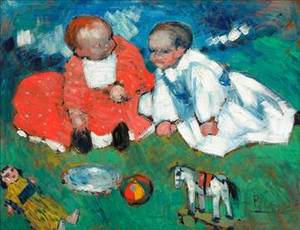 Would you buy the painting at right if you discovered it and knew nothing about the artist? Ah, but what if it’s by Picasso, which it is?
Would you buy the painting at right if you discovered it and knew nothing about the artist? Ah, but what if it’s by Picasso, which it is?
The early artistic output of renowned artists always fascinates me. This work, Les enfants et les jouets, will be up for sale at Christie’s in New York on May 3, with an estimate of $5.5- to $7.5 million.
It’s the second early Picasso to come on the market this year. In January, Christie’s sold Sur l’impériale traversant la Seine (below), deaccessioned by the Art Institute of Chicago, for $7.8 million (including commission). Both works were painted in 1901, when Picasso was 19.
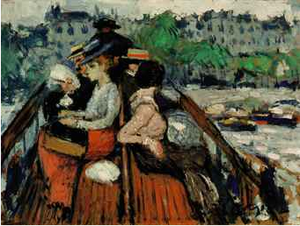 Picasso painted both in preparation for his first major exhibition, at Ambroise Vollard’s gallery in Paris, according to the press release. Says Conor Jordan, head of Impressionist and Modern Art at Christie’s, Americas:
Picasso painted both in preparation for his first major exhibition, at Ambroise Vollard’s gallery in Paris, according to the press release. Says Conor Jordan, head of Impressionist and Modern Art at Christie’s, Americas:
This scene of two small children amidst their toy horses and dolls is a work of irrepressible painterly élan. Picasso’s innate skill as a draftsman and his newfound excitement at the coloristic innovations of the Parisian avant-garde are evident in this work. Even at this early stage of his career, his searching eye found obvious enjoyment in the interaction of two infants, a theme he was to revisit throughout his legendary career.
Vollard seemed to think so. The Christie’s press release continues:
The painting may well have been among the more than 60 works selected for Vollard’s gallery show, which opened in June of 1901 to great critical acclaim. From a commercial standpoint, the exhibition was a rousing success for both the artist and for Vollard, with well over half of the paintings sold and enough income generated for the young Picasso to establish himself in Paris.
Really? Just for fun, to see how Vollard recorded this, I went to my copy of his Recollections of a Picture Dealer, and found this passage:
Towards 1901 I received a visit from a young Spaniard, dressed with the most studied elegance. He was brought to me by one of his countrymen…a manufacturer from Barcelona, Manache… Picasso, who, though only eighteen, had finished about 100 paintings, which he was bringing me with a view to an exhibition. This exhibition was not a success, and for a long time after Picasso got no better reception from the public.
Well, I guess it depends on what your definition of success is. Or how good Vollard’s memory was when he wrote his memoir (my edition is a reprinting of the 1936 English translation).
Since Gertrude and Leo Stein played such a large role in Picasso’s career, maybe more will be revealed when we see the upcoming show, The Steins Collect. Meantime, I’m going with the book.
Photo Credit: Courtesy of Christie’s

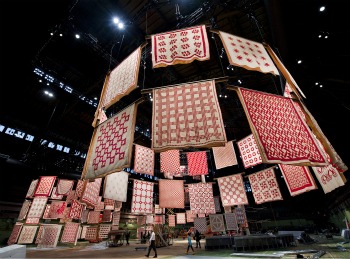 So the Park Avenue Armory has something to brag about, and it did (in a press release).
So the Park Avenue Armory has something to brag about, and it did (in a press release). 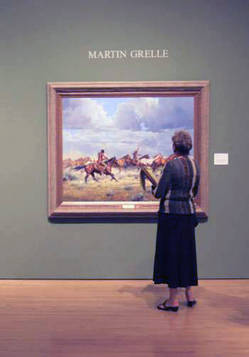
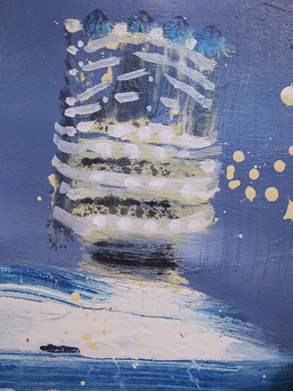 Here’s the list, and — to find what kind of work was deemed worthy — links to the best website about them I found: their own, their dealer’s, or another art website.
Here’s the list, and — to find what kind of work was deemed worthy — links to the best website about them I found: their own, their dealer’s, or another art website.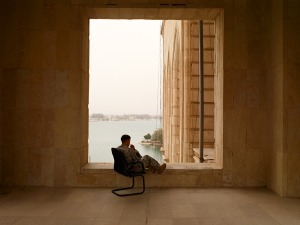 Bradford’s “Ferry” is above.
Bradford’s “Ferry” is above.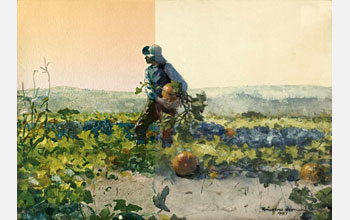 The latest involves two paintings at the Art Institute of Chicago: Winslow Homer’s For to Be a Farmer’s Boy (a watercolor made in 1887) and van Gogh’s The Bedroom (1889). Using new techniques on the Homer, scientists now know for sure that the sky — “starkly blank” now — was once “a vibrant autumn sunset, with organic purples and reds, in addition to inorganic reds and yellows.”
The latest involves two paintings at the Art Institute of Chicago: Winslow Homer’s For to Be a Farmer’s Boy (a watercolor made in 1887) and van Gogh’s The Bedroom (1889). Using new techniques on the Homer, scientists now know for sure that the sky — “starkly blank” now — was once “a vibrant autumn sunset, with organic purples and reds, in addition to inorganic reds and yellows.” 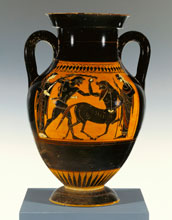 In another instance, the Metropolitan Museum of Art* is using new anti-body based research to “uncover the material world of art–the organic compounds mixed with inorganic materials that compose what we see in a painting, a sculpture or even costumes.” Discoveries were not disclosed so there may not be any — yet. But read more
In another instance, the Metropolitan Museum of Art* is using new anti-body based research to “uncover the material world of art–the organic compounds mixed with inorganic materials that compose what we see in a painting, a sculpture or even costumes.” Discoveries were not disclosed so there may not be any — yet. But read more